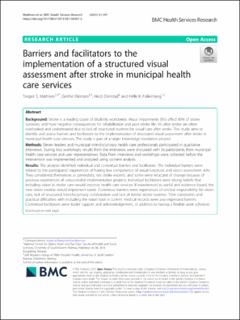| dc.contributor.author | Mathisen, Torgeir Solberg | |
| dc.contributor.author | Eilertsen, Grethe | |
| dc.contributor.author | Ormstad, Heidi | |
| dc.contributor.author | Falkenberg, Helle Kristine | |
| dc.date.accessioned | 2021-06-28T13:30:42Z | |
| dc.date.available | 2021-06-28T13:30:42Z | |
| dc.date.created | 2021-06-23T10:03:19Z | |
| dc.date.issued | 2021-05-24 | |
| dc.identifier.citation | BMC Health Services Research. 2021, 21, (1-13). | en_US |
| dc.identifier.issn | 1472-6963 | |
| dc.identifier.uri | https://hdl.handle.net/11250/2761710 | |
| dc.description.abstract | Background: Stroke is a leading cause of disability worldwide. Visual impairments (VIs) affect 60% of stroke survivors, and have negative consequences for rehabilitation and post-stroke life. VIs after stroke are often overlooked and undertreated due to lack of structured routines for visual care after stroke. This study aims to identify and assess barriers and facilitators to the implementation of structured visual assessment after stroke in municipal health care services. The study is part of a larger knowledge translation project.
Methods: Eleven leaders and municipal interdisciplinary health care professionals participated in qualitative interviews. During two workshops, results from the interviews were discussed with 26 participants from municipal health care services and user representatives. Data from interviews and workshops were collected before the intervention was implemented and analyzed using content analysis.
Results: The analysis identified individual and contextual barriers and facilitators. The individual barriers were related to the participants' experiences of having low competence of visual functions and vision assessment skills. They considered themselves as generalists, not stroke experts, and some were reluctant of change because of previous experiences of unsuccessful implementation projects. Individual facilitators were strong beliefs that including vision in stroke care would improve health care services. If experienced as useful and evidence based, the new vision routine would implement easier. Contextual barriers were experiences of unclear responsibility for vision care, lack of structured interdisciplinary collaboration and lack of formal stroke routines. Time constraints and practical difficulties with including the vision tool in current medical records were also expressed barriers. Contextual facilitators were leader support and acknowledgement, in addition to having a flexible work schedule.Conclusions: This study shows that improving competence about VIs after stroke and skills in assessing visual functions are particularly important to consider when planning implementation of new vision routines in municipal health care services. Increased knowledge about the consequences of living with VIs after stroke, and the motivation to provide best possible care, were individual facilitators for changing clinical practice. Involving knowledge users, solutions for integrating new knowledge in existing routines, along with easily accessible supervision in own practise, are essential facilitators for promoting a successful implementation. | en_US |
| dc.description.sponsorship | This project has been made possible by Dam Foundation. | en_US |
| dc.language.iso | eng | en_US |
| dc.publisher | BMC | en_US |
| dc.relation.ispartofseries | BMC Health Services Research;21:497 | |
| dc.rights | Navngivelse 4.0 Internasjonal | * |
| dc.rights.uri | http://creativecommons.org/licenses/by/4.0/deed.no | * |
| dc.subject | Strokes | en_US |
| dc.subject | Visions | en_US |
| dc.subject | Visual impairments | en_US |
| dc.subject | Knowledge translations | en_US |
| dc.subject | Implementation | en_US |
| dc.subject | Barriers | en_US |
| dc.subject | Rehabilitations | en_US |
| dc.title | Barriers and facilitators to the implementation of a structured visual assessment after stroke in municipal health care services | en_US |
| dc.type | Peer reviewed | en_US |
| dc.type | Journal article | en_US |
| dc.description.version | publishedVersion | en_US |
| dc.rights.holder | © The Author(s). 2021 | en_US |
| dc.source.articlenumber | 497 | en_US |
| cristin.ispublished | true | |
| cristin.fulltext | original | |
| cristin.qualitycode | 2 | |
| dc.identifier.doi | https://doi.org/10.1186/s12913-021-06467-4 | |
| dc.identifier.cristin | 1917863 | |
| dc.source.journal | BMC Health Services Research | en_US |
| dc.source.volume | 21 | en_US |
| dc.source.pagenumber | 13 | en_US |

